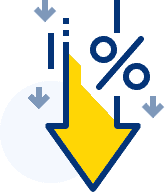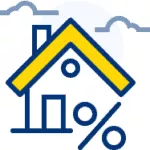Call Live Support

It is important for all Canadian homeowners to understand the definition of a home equity line of credit. We will cover everything there is to know about a HELOC.
Whether you’re looking to start a home improvement project, facing large medical expenses or need to access money from your home to purchase an investment property or preconstruction home? What if we told you that there’s a way to pay for all of those things at once?
All you need is a home equity line of credit. If you have equity in your home, you may be able to take out loans and lines, and credit.
To learn more about this opportunity, keep reading. A home equity line of credit, or HELOC, could be the answer to all of your financial problems.
A home equity line of credit, or HELOC, is a kind of revolving line of credit. HELOCs require you to use your home as collateral. In Canada, your HELOC cannot be more than 65% of your home’s value. This doesn’t mean homeowners can only borrow up to 65% loan-to-value. Homeowners can get a HELOC up to 80% of your home value, as long as the line of credit limit doesn’t exceed $650,000.
For example, if you have a property valued at $1,000,000, with a first mortgage balance of $150,000, you can get a home equity line of credit of $650,000, which is 80% loan to value. This is calculated as $150,000 + $650,000 = $800,000. $800,000/$1,000,000 = 80% LTV.
After you buy a home, you build home equity by making mortgage payments. Then, HELOCs allow loanees to pay off their loan via variable interest rates.
Plus, many lenders allow borrowers to pay off their HELOC loans at any time without penalty. borrowers can even reuse the line of credit.
A home equity line of credit works similarly to a credit card. As you repay your balance, you have more funds available to use within your credit limit. This means that you’re going to want to look for the following characteristics for a home equity line of credit:
The interest rate that you get will depend on your creditworthiness, income, and other financial factors. To get the best interest rate, you have to have a high credit score, a low debt-to-income ratio, and a fair amount of equity in your home.
Some lenders offer HELOCs to those with little to no income and/or poor credit, too. So, you shouldn’t let the examination of your credit history intimidate you.
You may have a slightly higher interest rate than those with better credit. But, you’ll still be able to qualify for a loan. Plus, some lenders are willing to work with those who are in tough financial situations.
Home equity lines of credit and home equity loans are similar, but they are not the same. There are a few differences that you should consider if you’re looking to take out one of these loans.
Firstly, home equity lines of credit have variable interest rates. This means that the interest on the amount changes throughout the lifetime of the loan. On the other hand, home equity loans have fixed rates.
Also notable is the APR (annual percentage rate). To clarify, the APR of a loan is the total amount of interest that you pay every year as represented as a percentage of the total loan.
A home equity line of credit can have slightly lower APRs than home equity loans. This means that you’re going to end up paying more in interest with a home equity loan.
We should note that home equity loans do not require an applicant’s income and credit into account. Plus, the homeowner can access more than 65% of their home’s value with a home equity loan. A home equity loan doesn’t have a maximum loan size limit, and homeowners can access up to 85% to 90% of their home value.
When you’re using a HELOC, you can draw as much as you need from the loan. This makes it easy to use the loan for unexpected payments. In contrast, home equity loans give a lump sum of a loan for you to use.
A HELOC also disburses payments. During the first five to ten years, you’ll only pay interest. After that, you’ll pay on the interest and the principal.
Home equity loans require you to pay fixed payments over the lifetime of the loan.
Lastly, a HELOC is better for individuals who are looking to perform home improvement projects, pay college tuition payments, or pay medical expenses. Home equity loans are best for debt consolidation, large home improvement projects, and major purchases.
Knowing all of this, you can make the best decision as to which loan is the best for your situation.
A HELOC is also similar to refinancing. Both offer ways for homeowners to leverage their home’s equity.
However, a refinance replaces the current mortgage that you have on your home. In turn, you receive a larger home loan. The difference in the loan amounts comes in the form of a lump sum.
HELOCs do not replace your current mortgage. Instead, it is an additional loan on top of your current mortgage.
Both methods are useful for those of you who are looking for more financial assistance. However, one or the other may be better for your personal financial goals.
Reach out to us if you’d like to discuss the best option for you. We can help you examine your financial goals and figure out which offer is best for you.
If you’re trying to decide between a home equity line of credit and a refinance, you should consider your current financial situation. A HELOC may be better for you if you fall under any of the categories below:
We should note that the interest that you pay on a HELOC may be tax-deductible if you use the loan for home improvements. This is why we highly recommend this loan for anyone who is only using the loan for this purpose.
If you feel that you didn’t fall under any of the previous categories, refinancing your mortgage may be a better choice for you. Here are some categories for those individuals who may be more successful using a refinance:
Lenders offering refinances may allow people to tap into more of their home’s equity. This could give you more money if you’d like a larger loan.
Get a quote to see how much of a HELOC limit you qualify for with monthly payments and interest rate options.
If a lender approves you for a HELOC, you’re going to get a line of credit that you can use during a specific time frame. Often, this credit limit lasts up to ten years.
Think about it like a limited-time credit card. You have a limit on that card, and you can only use that limit for a certain amount of time.
The period of time during which you can draw money is the ‘draw period.’ Once this period of time passes, you can no longer draw money from the loan.
Some HELOCs allow borrowers to pay both interest and principal on the loan during the draw period. Others only allow borrowers to pay interest during this time.
We recommend finding a HELOC that will allow you to pay both. Paying your principal off early is the key to lowering your overall expenses.
If you keep up with your payments, your lender may decide to take you on for another term. That is if you decide that you want to renew your home equity line of credit.
A Home Equity Line of Credit, or HELOC, is like a special bank account, but you use your home’s value as a way to get approval from the bank. Imagine the bank gives you a special debit card. This card lets you spend money up to a certain amount, and this amount is based on the value of your home.
When you get approved for a HELOC, the bank is saying, “We trust you to borrow this much money because we know your house is worth a lot.” This trust usually lasts for about ten years, but it can be different depending on the bank’s rules.
Think of it like having a special debit card with a set balance for around ten years. You can use it to pay for things like fixing up the house, paying off other debts, or handling unexpected expenses. But remember, you can only spend up to the limit the bank gave you.
During the time you can use your HELOC—the ‘draw period’—you have to start paying the bank back. Some banks let you pay back just the interest (the extra money the bank charges for lending to you), while other banks might want you to start paying back the money you spent (the principal) as well.
Once the draw period is over, you can’t spend from the HELOC anymore, but you’ll probably still have to keep paying back what you owe.
If you’ve been good about making payments, some banks might let you renew your HELOC for another set amount of years. This means you could continue to use it, as long as you and the bank agree on the terms again.
If you’re looking at getting a home equity line of credit, you may be wondering what kind of interest rates to look for. After all, this is a long-term loan that you’re going to have to pay off.
Many borrowers are wary of HELOC interest rates because they are paying a mortgage rate on top of this additional loan. They don’t want to be paying off these types of loans for the rest of their lives.
The interest rates do depend on the current economic climate since home equity line credits have variable interest rates.
Overall, lenders determine what your starting interest rate is going to be by looking at your current financial history. This includes your credit score.
Those with good credit may see interest rates of about three to five percent. Those with below-average credit may see interest rates of nine to ten percent.
To evaluate whether or not a lender has offered you a good interest rate for your home equity line of credit loan, you should research what the average interest rate is for the month and year in which you are applying for the loan. Generally, you can consider the interest rate to be a good deal if it falls below this average.
People use a HELOC in multiple different ways. Because these loans are flexible, they offer many benefits that other kinds of loans may not be able to give.
Most often, borrowers use HELOCs to pay for home improvement projects, remodels, and additions. However, you can also use these loans for debt consolidation.
Including these ideas, let’s look at common uses of HELOCs:
Many people favour HELOCs because of their interest rates, drawing flexibility, and diversity of use. HELOCs can help you get your finances in order in multiple ways.
Call us today to speak to a licenced mortgage broker.
Home equity lines of credit are best for individuals who want to have access to the funds over many years. At the same time, they should be comfortable using their home as collateral for the loan.
If you are not able to make payments towards your HELOC, you may lose your home. Make sure that you don’t stretch yourself too thin.
People who want to conduct multiple home improvement projects should consider taking advantage of a HELOC. The loan allows you to draw money as you need for ten to fifteen years. This can cover multiple, small projects that you may want to complete around your home.
If you’re going to apply for a HELOC while you have poor credit, there are a few things you should know.
First off, you have to understand that your credit score is the best predictor that financial institutions have for determining your creditworthiness. If you have a poor credit score, they have no reason not to assume that you’ve made poor financial decisions in the past.
However, those poor financial decisions do not have to stop you from getting a loan. Instead, they may alter the terms of your loan.
First, a lower credit score is going to bring higher interest rates. As we reviewed earlier, those with poor credit scores will likely see interest rates between nine and ten percent. However, this is still likely lower than any high-interest accounts that you have.
Lenders apply a higher interest rate to individuals with poor credit as a way of protecting themselves. If you have a poor credit score, lenders consider you a risky borrower. This means that lenders need to financially protect themselves (through higher interest rates).
The higher the interest rate that you receive, the more money that you’re going to pay over the life of a loan.
If your credit score turns sour while you’re in the draw period of your home equity line of credit, your lender can change the terms of the agreement on the loan. Likely, this would only happen if there were a large change in your financial situation.
For example, let’s say that the value of your home decreases while you’re in the draw period. In this case, your lender may decrease your line of credit or completely freeze your withdrawal ability.
If this happens, you may find yourself hurting for cash. Now, you have debt building up and no loan. Additionally, you may lose your home if you find that you can’t make the payments towards the HELOC.
This may sound scary, but there are lenders that are willing to work with you if you have poor credit. The best thing to do is call a broker. They can help you find the best loan for you and your current financial situation.
If you have good credit, you’re more likely to get better interest rates on HELOCs. You may also qualify for a bigger line of credit.
Generally, you should be able to receive a good home equity line of credit if you have a credit score of at least 725. However, you can receive a typical HELOC with a much lower score. The higher the score, the better the terms.
If you’re looking to qualify for a HELOC, you need to make sure that you’ve got your financial information in order. Often, HELOC lenders ask for the following information:
In general, a credit score of at least 620 will get you a basic home equity line of credit. However, individuals with higher credit scores will be able to get more from their loans. Most lenders also require a total loan-to-value ratio of 80% or less and a low debt-to-income ratio.
Overall, you’ll have an easier time qualifying for a HELOC if you have a better financial history.
Those who have poor credit and/or little to no income can still get a HELOC. But, they will have slightly higher interest rates. This is because loan acceptance is based on equity.
Just like any loan, there are advantages and disadvantages to consider. HELOCs do help people with large financial responsibilities, but they don’t solve all of your financial problems.
HELOCs are a financial responsibility that you have to make sure you take care of. If you don’t, you face losing your home. The consequences of not paying your bills may be bigger than ever.
You should make sure that you understand the pros and cons before you submit your application for a HELOC.
There are some characteristics about home equity lines of credit in Canada that you should know if you’re considering getting this kind of loan here. Keep these in mind as you’re shopping around for the best loan deal for you.
In Canada, you may be able to access up to 65% of your home’s value. You should also keep in mind that your HELOC and your mortgage loan balance cannot equal more than 80% of the value of your home.
If you want to calculate how much equity you can use, you should start by pinpointing your home’s current market value. Then, multiply this number by 80%.
Next, subtract your current mortgage balance. Now, you have the amount of money that you can access through your HELOC.
If this amount is not more than 65% of the value of your home, you’re good to use it all. If you’re unsure, divide this amount by your home’s market value. This gives you the decimal percentage of the amount.
Those with a home equity line of credit can use as much or as little of the loan as they choose. You only pay interest on the amount of money that you withdraw from the loan.
All of the credit that you have available is not given to you upfront. You only draw what you want/need.
Just like a credit card, you can pay off your balance and take out more money as long as you stay within your credit limit.
You are going to be making monthly payments on your home equity line of credit. That is as long as you have taken out any money from the loan.
Just like a traditional line of credit, a HELOC requires you to pay your balance on the same day every month. However, you are only required to pay the interest on the outstanding balance.
We recommend that you take the initiative to make extra payments as needed. This will help you pay off the loan faster.
Keep in mind that you will not break your mortgage in order to take out a HELOC. This means that you will avoid the mortgage penalty.
Most home equity line of credit lenders offer easy, online applications for their loans. All you need to do is give them the right personal and financial information that they need to determine whether or not you’re financially fit enough for the loan.
If you’re looking to apply, take these steps:
Arguably, the most difficult part of having a home equity line of credit is getting approved for a great offer. From there, you just need to budget your money and be smart about withdrawals.
All in all, you should make sure not to draw more money than you can payback. A home equity line of credit should help you with your finances, not give you more to worry about.
When contemplating acquiring a Home Equity Line of Credit (HELOC), securing the most favorable rates is crucial to ensure you’re not overpaying in interest. This means dedicating time to thorough research and comparison of available options is essential.
Opting for a HELOC demands a strategic and informed approach to ensure the obtained rates and terms are in your best financial interest. Leveraging professional advice, employing online tools, and exploring varied lending institutions are pivotal steps in uncovering the most beneficial HELOC options.
If you have further inquiries or seek more personalized guidance on home equity lines of credit, don’t hesitate to reach out to us to converse with a licensed mortgage broker who can address all your queries and assist you in navigating your way to the most suitable HELOC for your circumstances.

Low home equity line of credit rates from banks such as TD and Scotiabank.

Fast HELOC approval and closing. Equity approval options available.

Home equity line of credit options for bad credit homeowners

HELOC options for those with no income proof.

Get a home equity line of credit approved based on equity only.
There are a few ways to get approved for a HELOC in Canada. You can either qualify with your income and credit, or you can qualify with home equity only.

See your HELOC rate, and monthly payment

Confirm property value and current mortgage details.

Close on your HELOC in just 48 Hours


We take pride in taking the time and effort to match up every individual homeowner and homebuyer with the best mortgage financing options and rates. With access to more than 200 participating mortgage lenders, there are mortgage solutions for all types of borrowers. We listen and understand your mortgage and real estate goals, and find the best mortgage terms tailored to your specific goals to save you thousands of dollars on your new mortgage.

(No Obligation)